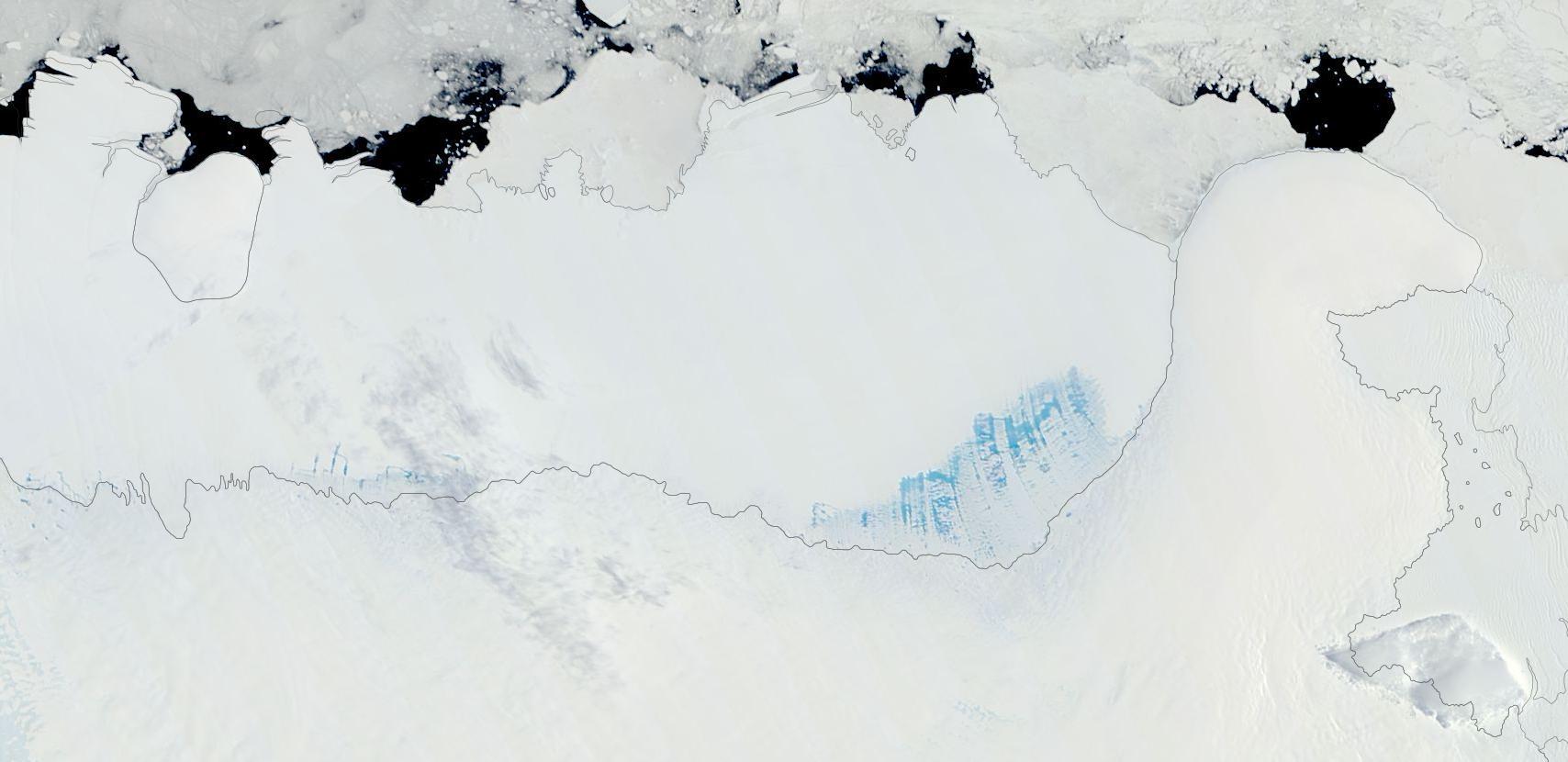Environment & Energy
Related: About this forumPonding, Surface Melt Expanding Rapidly Across Multiple E. Antarctic Ice Sheets
Around its edge zone, and from glacier top to ice shelf bottom, Antarctica is melting. Above-freezing surface temperatures during the austral summer of 2016-2017 have resulted in the formation of numerous surface-melt ponds around the Antarctic perimeter. Large cracks grow through Antarctic ice shelves as warmer ocean currents melt the towering glaciers from below. The overall picture is of a critical frozen region undergoing rapid change due to the human-forced heating of our world — a warming that has brought Antarctica to a tipping point, for such fundamental alterations to Antarctic ice are now likely to bring about a quickening rate of sea-level rise the world over.
Surface Melt Visible From Satellite
During 2016-2017, Antarctic surface temperatures ranged between 0.5 and 1 degree Celsius above the already warmer-than-normal 1979 to 2000 average for most of Southern Hemisphere summer. While these departures for this enormous frozen continent may not sound like much at face value, they’ve translated into periods of local temperatures up to 20 C above average. As a result, measures around Antarctica along and near the coastal zone have risen above the freezing mark on numerous occasions. These periods of much-warmer-than-normal weather have in turn precipitated widespread episodes of surface melt.
 ?w=600&h=538
?w=600&h=538
(This Antarctic volume-change melt map, which tracks thinning along various coastal ice shelves from 1994-2012, provides a good geographical reference for ice shelves experiencing surface melt or severe rifting. The Amery Ice Shelf [AME], King Baudouin Ice Shelf [BAU], and the Lazarev Ice Shelf [LAZ], stable through 2012, all showed extensive surface melt this summer. Meanwhile the Larsen C Ice Shelf [LAC] and Brunt Ice Shelf [BRU] both feature large rifts that threaten destabilization. Image source: Volume Loss from Antarctica’s Ice Shelves is Accelerating/Sciencemag.org.)
This year, one region in particular has seen temperatures hitting above 0 C consistently: the valley into which the Lambert, Mellor, and Fisher glaciers flow into the Amery Ice Shelf. There, warming has resulted in the formation of multiple large surface-melt ponds. The below image is a January 22nd NASA satellite shot of an approximate 100-by-40-mile section of this glacial outflow zone. The blue areas are melt ponds, some as large as 3 miles wide and 20 miles long.
The Amery Ice Shelf is one of East Antarctica’s largest. Like many of Antarctica’s ice shelves, Amery is melting, with about 46 billion tons of ice lost from this shelf alone each year. As with other Antarctic ice shelves, Amery’s melt is mostly below the surface, caused by warming ocean waters. However, in recent years, considerable surface melt on Amery’s feeder glaciers likely also contributed to significant volume losses in the shelf.
 ?w=600&h=292
?w=600&h=292
(Large melt ponds up to 20 miles long cover glaciers flowing into the Amery Ice Shelf on January 22, 2017. Image source: LANCE MODIS.)
Surface melt for Amery has become an increasingly prevalent feature since 2013, with 2017 melt for January 22 the most widespread for any of the past five years in this region. East Antarctica rarely saw large surface melt events prior to the 2000s, and this year’s warming and large melt ponds are a considerable feature. While basal warming is often the cause of the greatest mass losses, surface melt can act like a giant wedge driven into ice shelves, helping to break them up. Melt wedging in glaciers can also increase their forward rate of movement as heat content rises and as the points at which glaciers contact the ground become lubricated.
Moving north toward Dronning Maud Land along the East Antarctic coast, we find another region of surface melt ponding on the King Baudouin Ice Shelf. Nearly as widespread and extensive as the melt on the Amery Shelf’s glaciers, the King Baudouin melt is no less impressive and concerning.
 ?w=600&h=292
?w=600&h=292
(King Baudouin Ice Shelf shows extensive melt ponding along a 40-mile swath of its southwestern corner in January 2017. Image source: LANCE MODIS.)
EDIT
https://robertscribbler.com/2017/01/23/abnormal-antarctic-heat-surface-melt-giant-cracks-in-ice-shelves-more-troubling-signs-of-a-world-tipping-toward-climate-chaos/
Anonymous Bosh
(28 posts)I wonder why it's essentially losing ice on one side but gaining some on the other?
hatrack
(59,602 posts)The ponding/melting episodes described in the rest of the article are a very recent phenomenon - basically from austral summer 2016 through the present, so about one year.